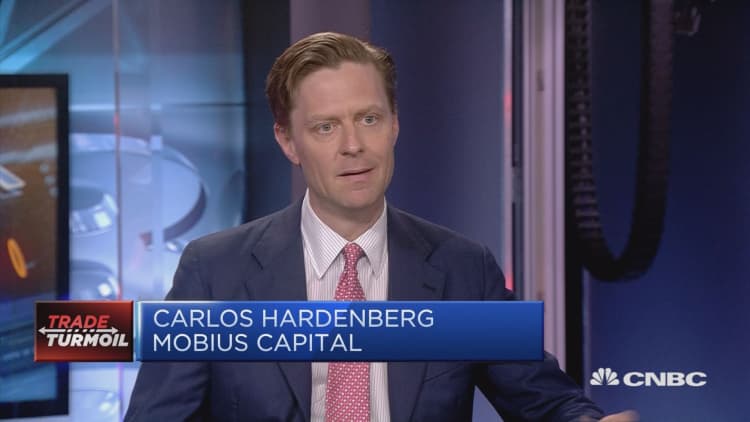Now is the time to focus on emerging market assets, one leading investor said Wednesday, despite serious strain brought on by a rallying dollar and higher borrowing costs.
The advice may appear counterintuitive in current market conditions. Emerging economies have been squeezed for a few months now amid a strengthening U.S. dollar and a range of idiosyncratic pressures like weakening currencies, high inflation and political uncertainties.

“I’d say, in general, emerging markets are seeing a perfect storm brewing once again,” said Carlos Hardenberg, partner and co-founder at emerging markets asset management firm Mobius Capital.
“The macro situation is getting tighter and tighter, you’re seeing a run on the currencies, talk of the investor community really turning more and more negative toward riskier assets,” he said during an appearance on CNBC’s “Squawk Box Europe.”
He added: “That is typically the time where it is best to look at these opportunities, and where they become more reasonably priced.”
And contrary to market bulls who have been capitalizing on strong growth in the U.S., Hardenberg said that is precisely where he sees the most reason to worry.
“I would rather be concerned about the U.S.,” he warned. “I think the U.S. market looks very, very toppy. I think it’s right for a more pronounced and more significant correction in the U.S., and I also don’t think the strengthening of the U.S. dollar can be justified over the long term.”
Numerous investors are calling for an impending correction, including who said that a “very major correction” was due, and Centricus Asset Management’s Ralph Jainz who called the current stock market
“There’s a lot of positivity which is increasingly priced into the U.S. dollar… However, the U.S. totally depends on refinancing its deficits and depends on its relationship with China,” Hardenberg said. “So the dollar from a longer-term perspective to me looks very fragile. So if you assume the strengthening of the U.S. dollar is not going to last for very long, that’s actually better news for emerging markets.
Which way for the dollar?
Currency analysts at HSBC wouldn’t necessarily agree. The bank’s chief currency strategist, David Bloom, announced early this month that there was at the moment, because “the greenback is back, the cyclicality of the U.S. economy is superb.
But market watchers are divided over the trajectory of the buck — in a mid-June Reuters poll of 60 analysts, more than half believed the dollar’s run would last only three months.
The dollar is now the highest-yielding currency in the G10, up nearly 7 percent from its 2018 low in February. According to a note from Goldman Sachs: “Solid U.S. growth, Fed hiking and weaker non-U.S. activity are the standard recipe for U.S. dollar strength. Trade war fears are also having a softer impact on the U.S. economy’s outlook thanks to the economy’s current resilience.”
But looking beyond what will likely be strong gross domestic product (GDP) figures in the second quarter, there are “clear risks that there will be some deceleration from an unsustainable growth rate,” according to Derek Halpenny, a global markets research head at MUFG. “Most short-term indicators we look at are now flashing warnings that FX sentiment has reached excessive levels.”
Political uncertainty in emerging markets
Still, this does not mean easy sailing for emerging markets in the near-term. Higher borrowing costs and trade war fears, as well as political uncertainty, debt problems and inflation levels in countries like Brazil, Argentina and Turkey are keeping many investors away and intensifying currency selloffs.
Per Hammarlund, chief EM strategist at Nordic bank SEB, underlined a major worry ahead: “The increasing threat of a trade war is weighing heavily on equities and currencies in export-dependent emerging markets.”
But markets have seen far worse, Hardenberg said, brushing off any doomsday forecasts. He described companies in emerging markets as being more accustomed to volatility, and as a result they’ve de-leveraged their balance sheets and diversified their businesses and export partners. In Asia alone, for instance, former dependence on U.S. and European Union export markets has been slashed as more than half of Asian exports are now being consumed in Asia itself.
“These markets are always very politicized,” the Mobius co-founder said, noting that politics play a larger role in impacting market prices than in the developed world. He also cited the Russian and Asian stock market crises of the 1990s, saying, “We’ve been here before.”


